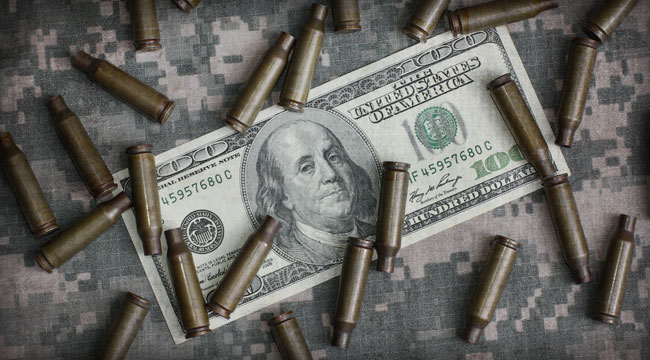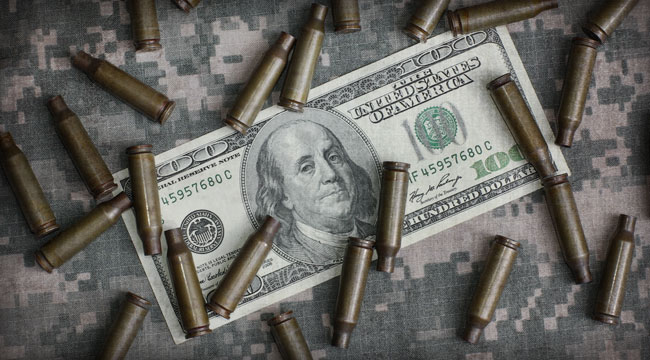The following is the prepared version of a speech delivered at the Ron Paul Institute Conference in Sterling, VA.
I am here today to talk about one of the most important, but also most overlooked, issues of our day: the relationship between central banking and total war. When you focus on central banking and the problems that result from it, it’s very easy to see how central banks enable larger, more centralized, and more pervasive governments. But it isn’t always easy for those who oppose war to see how central banks enable war. So I’ll go ahead and give you kind of the 10,000 foot view of the symbiotic relationship between central banking and war.
One of the primary activities that states engage in is fighting wars. But wars cost money. Armies march on their stomachs, and someone has to buy the necessary food and transport it. Weapons and armament cost money too, all of which has to be paid for. So where have kings and governments historically gotten that money from, particularly when their own treasuries ran out? As Willie Sutton could have told them – banks.
Banks developed initially as a means for merchants to store their funds safely and securely. But eventually those banks took in so much money that they got the idea to loan out some of those funds, hoping that they could juggle loans and receive enough payment on outstanding loans to satisfy demands for redemption by depositors. Thus was born fractional reserve banking and the recourse to banks as lenders of money. Sure, kings could expropriate money from banks, but that only went so far. If you continued to rob banks outright, they would eventually either hide their money or disappear from the kingdom and the king was left with no money to fight his wars. So what developed was a relationship that has developed over time and become ever closer and more symbiotic over the course of time between banks and governments.
It’s a classic “I’ll scratch your back if you scratch mine” type of relationship. In exchange for providing funds to governments, banks got special privileges in return. One need look no further than the Bank of England, the first really modern central bank and the model for numerous other central banks, to see this principle in action. The Bank of England was founded in 1694 with the purpose of providing funding to the English government to rebuild its navy. The Royal Navy had lost badly to the French Navy and the British sought to rebuild and rearm. The Bank took in money from investors, provided it to the government in exchange for government bonds, and was then given the privilege of issuing banknotes against those bonds.
Over the bank’s history it continued to receive additional privileges from the English government, eventually culminating in gaining a monopoly over banknote issuance in 1844. There were various other barriers to entry that were put in place to keep people from competing against the Bank of England. Smaller, private banks just could not compete with the government privileges given to the Bank of England. And as it got larger and larger it got too big to fail and every time it was going bankrupt the government would bail it out and in exchange the Bank of England would give the English government a lot more money to fight wars.
One of the first casualties of wartime is fiscal and monetary discipline. No matter how little spending a government did before it goes to war, once it engages in war there is no limit to how much money it wants to spend. National debts increase, borrowing increases, taxation increases, all in an attempt to win the war. In particular, under a specie standard, specie redemption is one of the first things to go. This means that depositors can no longer take their banknotes to the bank and redeem them for gold and silver. The Bank of England was the beneficiary of many government measures over the years to suspend specie redemption at many points throughout its history, particularly during the period of 1797 to 1821 when the gold standard was suspended in order to fight against Napoleon.
But suspending specie redemption is not just limited to England. It has happened in the United States on numerous occasions. During the War of 1812 specie redemptions were suspended. Throughout the various financial panics of the 19th century, specie redemption was suspended. During the Civil War specie redemption was suspended. And the Civil War is very important in understanding the relationship between central banking and war in the United States.
The Civil War saw the passage of the Legal Tender Act and the National Banking Acts. The first issuance of unbacked paper money currency in the United States, the so-called “greenbacks,” was the Legal Tender Act. And the establishment of the national banking system which we all take for granted today was the result of the National Banking Acts. These acts had as their purpose the establishment of a national banking and monetary system for the purpose of funding and conducting the war against the Confederacy. Remember that the privilege of engaging in the banking business has almost always been tied to purchases of government debt. If you wanted a state charter you had to buy state debt. If you wanted a national charter your had to buy federal government debt. That, once again, demonstrates the link between centralizing the banking system and engaging in total war.
Look at the founding of the Federal Reserve System just before World War I. The Federal Reserve was founded ostensibly to provide for an elastic system of currency and to overcome the financial panics that had plagued the economy. But during World War I the Federal Reserve was actively involved in the war effort through its marketing of Liberty Bonds. Government spending on training, weapons, and munitions increased tremendously after the United States entered the war, so the Treasury was forced to rely on bond issuance to fund its spending. Not only did the Fed act as a marketer of the bonds, and as a fiscal agent of the Treasury for these bond sales, it also lent money to member banks at low interest rates if they used that money to purchase the bonds. It was essentially increasing the money supply and artificially stimulating demand for the bonds. By 1919 the money supply was nearly double what it had been in 1914, with of course a corresponding rise in prices. That resulted in the “Forgotten Depression” of 1920-21, about which authors such as Tom Woods and Jim Grant have written.
The Fed continued its support of war efforts during World War II, stating that it was “prepared to use its powers to assure at all times an ample supply of funds for financing the war effort.” That became the focus of the Fed’s mission throughout World War II. War bonds were once again issued by the Treasury and marketed by the Fed. The Federal Reserve Banks agreed to purchase Treasury Bills at a 3/8 percent interest rate, which was pegged until 1947. The Fed was even allowed to purchase securities directly from the Treasury. Of course, this easy flow of money was quite welcome as the government continued to expand in the aftermath of World War II, so the Fed continued to peg interest rates until the 1951 Treasury-Fed accord.
Even after that, however, the Fed continued to engage in expansionary monetary policy. Remember that private ownership of gold was banned in 1933, so gold coins and gold certificates could no longer circulate as money. The American people could no longer act as a check on expansionary monetary policy by redeeming their dollars for gold, only foreign governments could. Over the course of the 1960s, the overall money supply nearly doubled as the US government engaged in the guns and butter policies of President Johnson. Foreign governments saw this happening and began to redeem their dollars for gold. This prompted President Nixon to close the gold window in 1971. Since that time there has been no constraint on the Federal Reserve’s ability to create money, which is why we have seen a massive increase in the size and scope of the federal government since then. We no longer have a gold coin standard or a gold specie standard, or even a gold exchange standard to act as a check on money creation. It is no coincidence that the massive growth of government has come about at the same time as the massive growth in the size and influence of central banks.
You can’t fund a $4-5 trillion government budget, you can’t fund military bases in 100+ countries around the world, you can’t fight a massive internal war against drug users, you can’t fund an open-ended war on terror, you can’t fund an omnipresent surveillance state without the existence of a central bank. Governments can’t keep to their budgets, so they resort to borrowing. Central banks continue to ensure that there are ready buyers for newly-issued government debt and that the bond markets remain large and liquid. They ensure that the national banking cartel that exists in this country continues to maintain its privileges: government-subsidized deposit insurance, Federal Reserve bailout facilities, and barriers to entry that prevent competition in the banking sector. They ensure that banks who loan money to the government maintain their privileged, protected status. If you really want to control government’s ability to go to war, you have to eliminate cheap, easy money, and that can only come about by ending the system of central banking that exists today.
Reprinted with permission from the Carl Menger Center.



